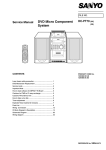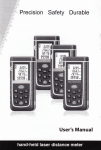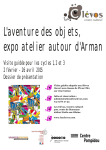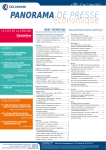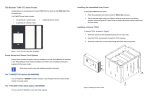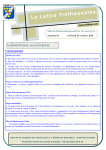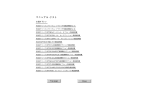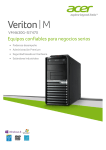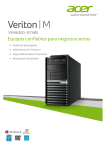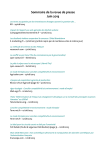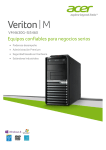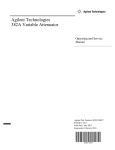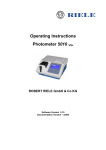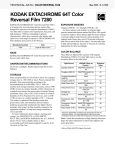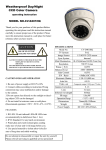Download Untitled
Transcript
TITLE: OPTRONICS User Manual P. Grosbol , ESO - Garehing June 16 , 1981 PURPOSE: User guide for the O~ICS rneasuring machine C. Euler , Roorn no, 222 ID:: User TYPE: AtJrHOR: REV: CHAP.I'ER 3 OPERATION OF OPI'RONICS 3.1 INI'RODUC!'ION Preparing the microdensitometer for operation involves rnany steps which can be performed in rnany different ways. It is suggested, however, to follow the steps as outlined in this section. Only operations of the microdensitometer is described in this manual while instructions for operation and running the scan control programs are found in the Compute Prograrn section pf the manual. Note that all functions of the OPrroNICS machine are controled by the satellite computer. Therefore, it is essential that the satellite control prograrn is loaded and running. If same functions are not working properly try to run the prograrn 'READY' and reload the satellite computer. 3.2 1. 2. 3. 4. S. 3.3 1. 2. STARTUP PROCEDURE Check that the power is on to the system rack and the microdensitome The X/y coordinate display on the rack should be lit. Check that the microdensitorneter Larep is lit. If not call for help! Run the control prograrn 'OPrro' or the user application program on the terminal. Switch the ON/STANDBY switch to ON by pressing the ON button on the main control panel. Check that the stage can rnove in both X and Y direction by pressing the X/Y positon buttons on the main control panel. If it cannot be moved call for help! CIDSElXMN PROCEDURE Terminate the control program. Switch the lamp switch on the system rack to NORMAL position. OPERATION OF OPl'RONICS Page 3-2 3.4 OPrICAL CALIBRATION The optical calibration and adjustment consist of rnounting p1ate, selecting slit and aligning optics. The two 1atter items are not needed when only manual measurements are made. 3.4.1 Plate Mounting 1. 2. 3. 4. 5. For the most corranonly used plate sizes special adapters are available ( see Table 2.5 ). If other p1ate sizes are used a glass platen should be placed in the plate adapter. Move the stage in the Y-axis towards the main control panel stopping it approxirnately 10 cm before the end. Attach the plate adapter to the stage and fasten it using the clip and thumbscrew in the corner , Each adapter has three reference dowel pins and a clip in one corner , Place the p1ate in its adapter and align against the reference dowe1s. Use the clip to push the plate against the dowles. Tighten the thumbscrew on the clip to secure the plate in its adapter. 3.4.2 S1it Selection 1. 2. 3. 4. 5. Find the best eyepiece / objective / slit combination yielding the scanning slit desired ( see Table 3.1 ). Note that norrnally the 5x objectives will be mounted, and that objectives only will be changed in special cases ( contact staff member in charge ). Se1ect the lower eyepiece on the lower control panel by turning the MAGNIFICATION knob. Install the upper eyepiece in the upper microscope. Its magnification must be identical, to that chosen for the lower eyepiece. A change is done by bringing the microscope to full down position, unscrewing the top part, taking it out, replacing the eyepiece and remounting the top part. Select the pres1it on the lower control panel using the FIXED APERrURE knob, Match the corresponding slit on the slit-wheel (i.e. the leftmost wheel) inside access door on the rigth side of the brigde. The slit number pointing upwards on the slit-wheel should be identical to the preslit number selected on the lower control panel. 3.4.3 Optical Alignment 1. 2. 3. Engage field illuminator by turning ILLUMINATION knob on the lower contro1 panel to IN position. Focus the plate on the viewing screen by using the focus knob on the upper microscope. Check that a good focus is obtained over the entire area OPERATION OF OPl'RONICS Page 3-3 which has to be scanned by moving the stage rnanually to different positions on the plate. If this not the case adjust the -horizontal level of the stage using the two micrometric screews below the stage ( one on each side ). 4. Remove the cape from the telescope to the left of the viewing screen. Focus the telescope by pulling a little out. The slit aperture should now be sharp. 5. Switch the ILLUMINATION knob on the Iower control panel to OUT position. 6. Focus the preslit on the viewing screen using the u:MER FOCUS buttons on the main control Panel. Since the focus is adjusted in very small steps it may take some time before a goOO focus is reached. It is easier to determine the best focus when the plate is positioned on an area with low density. . 7. Check that the preslit is positioned close to center of the viewing screen crosshair. If this is not the case ask the staff member in charge to adjustithe upper microscope body. 8. Use the viewing telescope to the left of the screen to center the preslit and the main slit. Alignment is accomplished by turning the knobs inside access door on the right side of the bridge. The first knob adjust the X-axis, the next the Y-axis, and the third the rotation. 9. When not in use place the telescope cap on the telescope to avoid that roan-light can reach the PMT. 3.5 ANALOO SYSTm CALIBRATION The calibration of the analog system must be done with the ILLUMINATION knob on the lower control Panel in OUT position. The microdensitometer spot should be positioned on the area of the plate which should be defined as density 0.0 or transmission 1.0 (e.g. clear glass plate or plate fog ). It must be noted that the OPTRONICS does not measure absolute density or transmission values. Since the ca1ibration is sensitive to any in the optica1 system (e.g. refocusing) a new change ca1ibration have to be performed when ever such changes are made. 3.5.1 Transmission Mode 1. 2. 3. 4. 5. 6. Select transmission mode on the main control panel by pressing the DENS button until the TRANS control lamp is lit. Check that the ILLUMINATION knob on the lower control panel is in OUT position. Place a dark piece of paper on the plate so that it obscures the light beam. Close the viewing screen and set the cap on the telescope. Adjust the ZERO LEVEL potentiometer on the main control Panel for a DIGITAL METER reading of 5 units. Remove the paper from the plate. Position the plate on the area of the plate which should be defined as transmission 1.00. The viewing screen may be opened. OPERATION OF OPTroNICS 7. Page 3-4 Select a neutral filter combination to obtain the lagest Mm'ER reading less or equal to 4050 units ( the I F I command in the control program may be used to get the best setting ). The neutral filters are ·selected by rotating the two rightmost wheels inside the access door at the right side of the bridge. If a sufficiently high METER reading cannot be ,reached the larnp switch on the rack may be switched to MAX position. 3.5.2 Density Mode 1. 2. 3. 4. 5. 6. 7. 3.6 Select density mode by pressing the DENS button until it is lit. Check that the ILLUMINATION knob on the lower control panel is in OUT position. Place a dark piece of paper on the plate so that it obscures the light beam. Close the viewing screen and set the cap on the telescope. Adjust the ZERO LEVEL potentiometer on the main control panel for a DIGITAL METER reading of 5 units. Remove the paper. from the plate. Position the plate on the area of the plate which should be defined as density 0.0. The viewing screen may be opened. Select a neutral filter combination to obtain the largest METER reading less or equal to 4050 units ( the 'F ' cornmand in the control program may be used to get the best setting ). The neutral filters are selected by rotation of the two rightmost wheels inside the access door at the right side of the bridge. If a sufficiently high METER reading cannot be reached the larnp switch on the rack may be switched to MAX position. SCANNING After the optical and analog systems are calibrated measurements can be made. The telescope and viewing.screen should be covered when the machine is measur ing • Scans can be performed· by running the proram I OPTRQ I (either online or offline) or a user application program on the central computer. These programs are described in the Computer Program section of the manual. OPERATION OF OPI'RONICS Page 3-5 Table 3.1 Scanning aper~ure f~"micron 5x objective lex objective --Aperture Eyepiece 15x 2ex '5 " 3.3 x 3.3 2.5 x 2.5 6.7 x 6.7 lex 5x 1 Hl x leJ 5 2 213 x 20 10 ~x 10 3 30 x 30 15 x 15 . .'." Xt 4 513 x 50 "" 25 x 25 5 15 x 140 7~5 x 713' 6 10 x 140 5 x 7 15 x 280 8 10 x 280, 5 x 5 x 10 7.5 x 7.5 17' ' x 17 12.5 x 12.5 lß 5 x 42 3.8 x 35 3~3 x 42 2.5 x 35 "7 ~5x 1213 5' x 813 3.8 x 60 5 ' x 120 3.3 x 80 2.5 x 80 713









